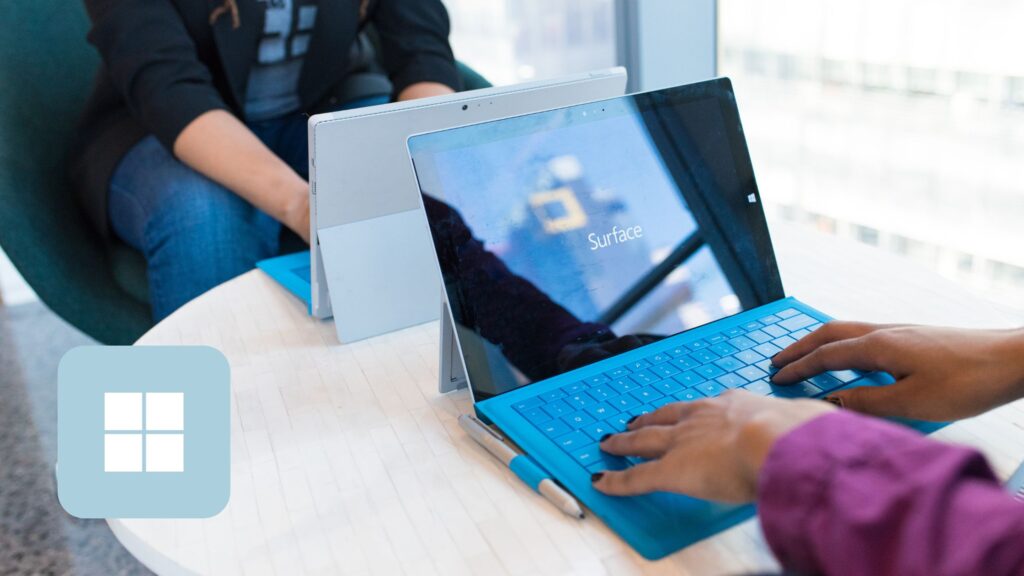
Stop me if you’ve heard this one before: some colleagues walk into a meeting and no one knows why they are there. Everyone has a different set of agenda items they want to discuss. By some miracle, decisions are made and action items assigned, but where is this documented (if it’s even been documented at all)? Several months later, someone is trying to find one specific decision from that meeting. But where do they even start looking for this information?
If you’re silently screaming at the familiarity of this, thinking to yourself “there must be a better way,” you’re right! Microsoft OneNote is a must have application, not only for increasing your own productivity, but also for your entire team. Let me take you through how Regroove uses OneNote to save time and increase collaboration during meetings.
The Basics – How Does OneNote Work?
OneNote has an intuitive organization structure. Those who have used binders to organize notes will be right at home. For example, you can create separate notebooks for each subject, or department, or project. Each notebook can be divided into different sections, much like dividers in a binder. Finally, each section will contain one or more pages.
Hot tip: You can add even more organization to this structure by combining related sections into groups, or by creating sub-pages, or sub-sub-pages.

But wait, there’s more! Just like a binder, you can move the sections and pages around by simply dragging and dropping them. What could be easier?
At Regroove, we pin shared OneNote notebooks to our Microsoft Teams channels by using the + button in the top navigation bar to ensure everyone can easily find the notes and have ready access. If the Microsoft Team does not already have a shared notebook, the + button can also be used to create a new shared notebook from within Microsoft Teams. We use colour coordination and naming conventions to make sure everyone knows where to find the information they’re looking for. In this case, we use the teal colour, and C – prefix to indicate that it is a Client notebook. The sections are colour coordinated and following our internal naming conventions as well.

Hot tip: When a notebook or section is created, a color is automatically assigned to each notebook and section. By right clicking the notebook (and selecting Properties) or section (and selecting Section Color or Rename), you can easily update their colors and the names.

Want more customization? You can even add emojis to your OneNote notebooks. Not just to the pages, but to the names of notebooks, groups, and sections, too. Use WIN + . on a Windows computer to bring up an emoji selector and give it a try.



Now that you know the basics, let’s get back to meetings.
Customizing Your Meeting Agenda
If you’ve ever had to lead a meeting, you know the agenda can be your greatest ally. It ensures everyone attending the meeting knows what is going to be covered, and sometimes more crucially, what is not going to be covered.
Here at Regroove, we like to use templates to make our agendas a breeze to prep. There are two ways you can use templates to your advantage.
- Create a pre-formatted agenda and make a copy for each new meeting. OneNote allows users to make a copy of any section or page, and place it into any OneNote notebook, even if it’s not the one holding the template itself. This is best if you have several different templates you want to use, depending on the occasion.
- If you always use the exact same template, you can set up OneNote so that all new pages in a specific section are pre-formatted in the same way. For example, if I wanted to make the meeting agenda below the default page for my Project A section:
- Open the page that currently has the template.
- Go to Insert in the top navigation bar.
- Select Page Templates. This should open up the side navigation section on the right hand side of the page.
- Select Save current page as a template.
- A pop up will appear asking for the template to be named. Make sure to select the checkbox to Set as default template for new pages in the current section. Select Save.
- After which, whenever Add Page is selected, the new page will be the saved template (7).
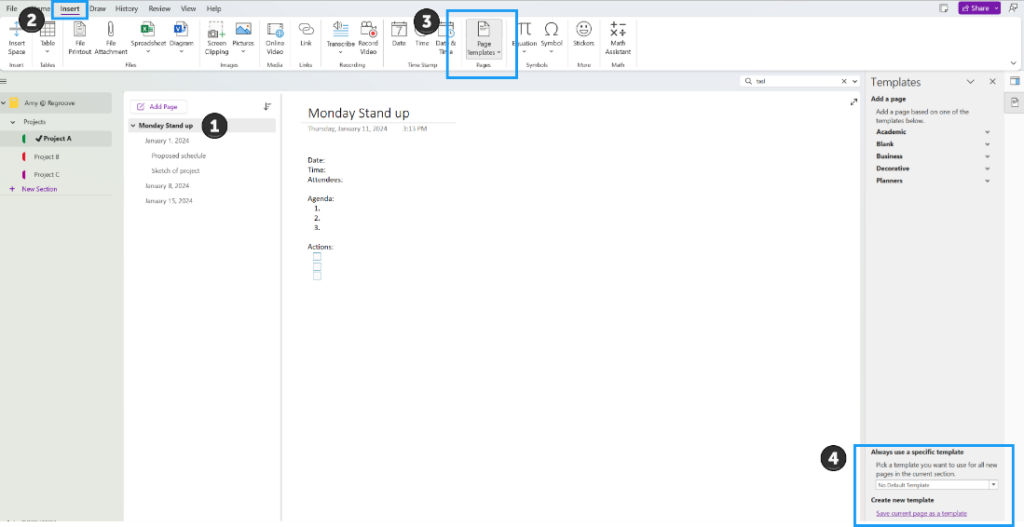


OneNote can automatically insert the meeting details, including the date, time, and attendees into your agenda page with the Meeting Details button. If the meeting calendar event has notes or links attached in the Description, this information is also automatically added to your agenda. Supplemental information, like images, PDFs, links, even audio and videos can be added to the agenda directly for attendees to review.
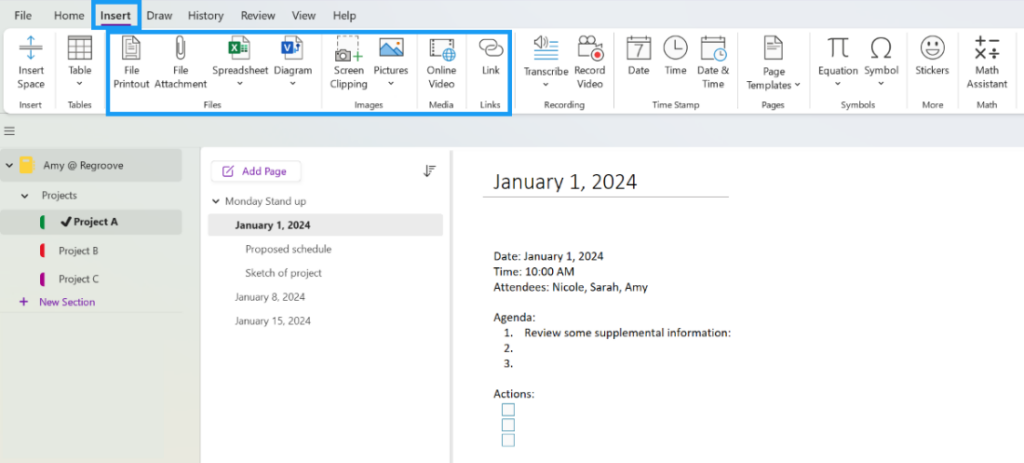
But making the agenda is only half the battle. How do you make sure everyone is on the same page? By literally taking everyone to the same page!
Each notebook, section of a notebook, or even a specific page can be shared as a link. If you want to make sure someone sees a specific agenda item, you can send them a link that will take them directly to that line as well. Everyone who has access can then review and edit the same agenda.
Running Your Meetings with OneNote
Everyone is finally talking about the same meeting topic because of your agenda and OneNote’s collaboration tools, but what now? During the meeting, anyone who has access to the notebook can follow along and see the notes that have been taken for each item.
As decisions are made and tasks assigned, tags can be used to add some visual reminders and categorizations. OneNote has some standard tags like Important, Question, or Task right out of the box, but you can also modify existing, and create new tags to suit your purposes. You can even use tags to send tasks to your Outlook and Microsoft To Do!
Adding the tasks using the Outlook Tasks button:
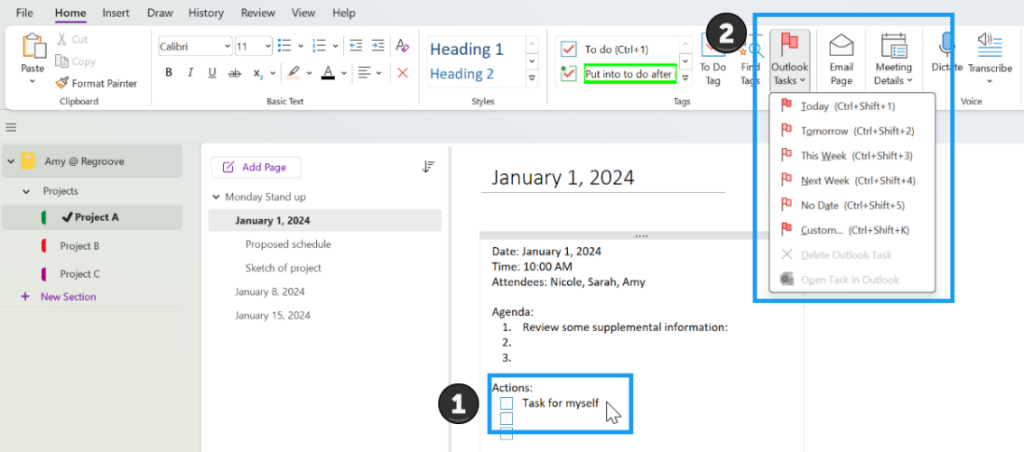
A flag will appear beside the task:

The task will appear in your Outlook My Day:

As well as your To Do application, if they are connected.
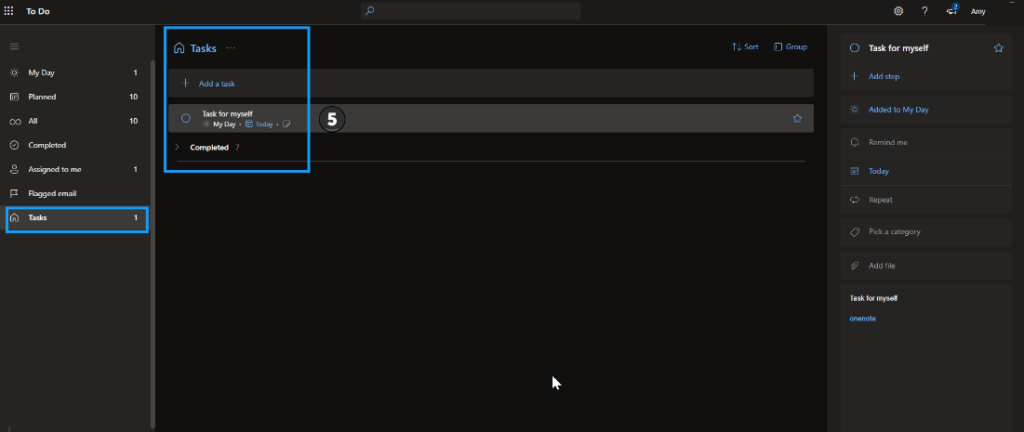
After The Meeting
Anyone who is shared to the notebook, section, or page can read the notes anytime. If your organization has the appropriate privacy and security settings, you can even share OneNote with individuals outside of your organization. OneNote’s Email Page button can send the contents of a page directly to recipients.
Regroove always has Page Versions turned on, which allows anyone to see who has contributed to the notes over time, even after the meeting has ended.
If people have used the Outlook My Day button to add their tasks to Outlook and To Do, the status will automatically be updated in OneNote as they complete their tasks.
As tasks are completed in Outlook My Day (below) or Microsoft To Do (not pictured),

The associated task in OneNote will be updated with a green checkmark to indicate the task has been completed!

If it is several months later and someone needs to find that one decision or action item, you can search for keywords in all your notebooks at the same time, or just one specific notebook, section, or page if you have an idea of where you should be looking. If you used tags, you could also use the Find Tags button to look for a specific tag.
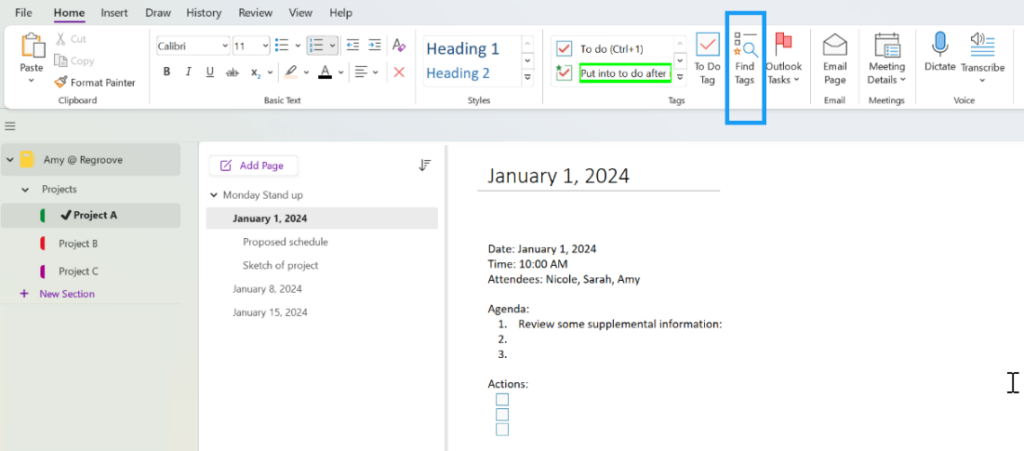
Hot tip: Anything that is not an unchecked checkbox will be removed from the Find Tags search results if you select Show only unchecked items. This allows you to zero in on uncompleted tasks and ignore all other tags, like Question or Important.
Ready to give it a try yourself? You can download Microsoft OneNote now and start using it for free!
Microsoft has been working on OneNote for a very long time (since 2003!), which means it has very robust capabilities to support you and your organization. If you want more information on how OneNote can help your organization streamline your meetings, fill out the support form below and our team will be in touch.